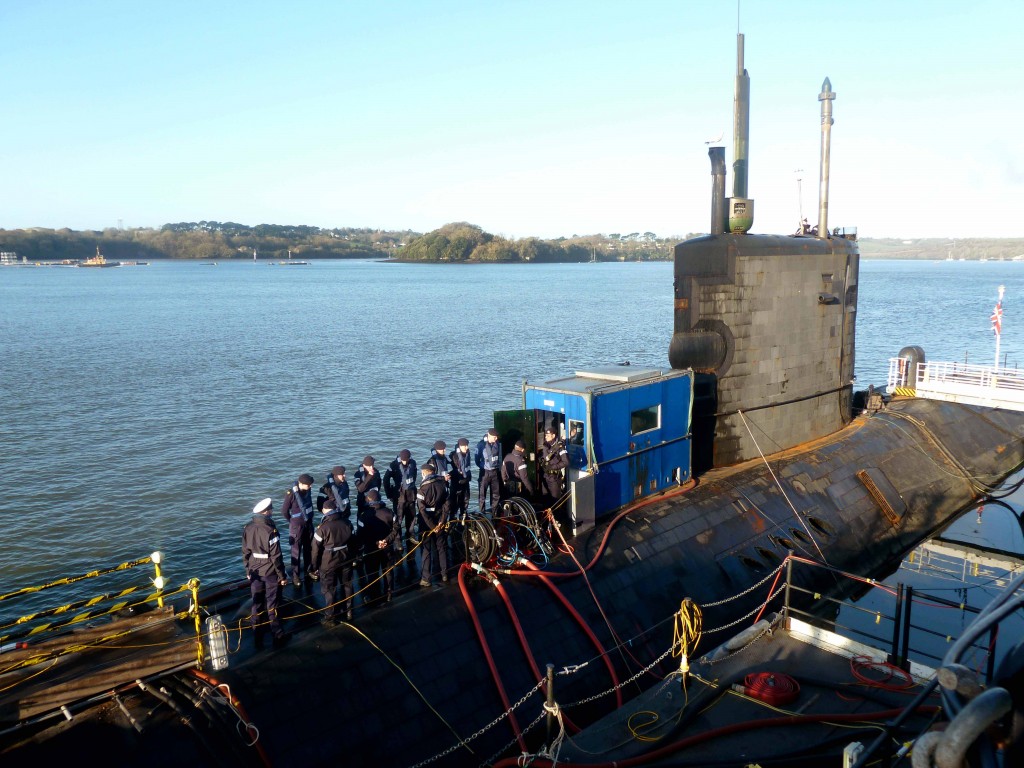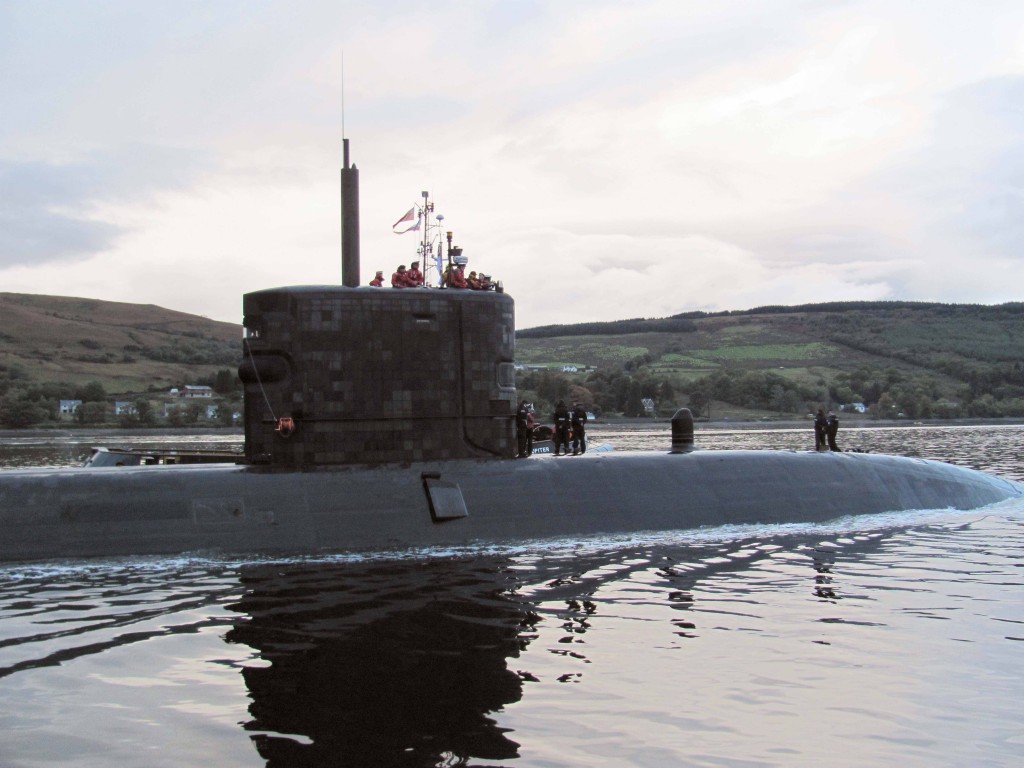Submarines are incredible pieces of technology. Not so long ago, a naval force worked entirely above the water; with the addition of the s¬ubmarine to the standard naval arsenal, the world below the surface became a battleground as well. The adaptations and inventions that allow sailors to not only fight a battle, but also live for months or even years underwater are some of the most brilliant developments in military history.
A submarine or a ship can float because the weight of water that it displaces is equal to the¬ weight of the ship. This displacement of water creates an upward force called the buoyant force and acts opposite to gravity, which would pull the ship down. Unlike a ship, a submarine can control its buoyancy, thus allowing it to sink and surface at will.
To control its buoyancy, the submarine has ballast tanks and auxiliary, or trim tanks, that can be alternately filled with water or air (see animation below). When the submarine is on the surface, the ballast tanks are filled with air and the submarine’s overall density is less than that of the surrounding water. As the submarine dives, the ballast tanks are flooded with water and the air in the ballast tanks is vented from the submarine until its overall density is greater than the surrounding water and the submarine begins to sink (negative buoyancy). A supply of compressed air is maintained aboard the submarine in air flasks for life support and for use with the ballast tanks. In addition, the submarine has movable sets of short “wings” called hydroplanes on the stern (back) that help to control the angle of the dive. The hydroplanes are angled so that water moves over the stern, which forces the stern upward; therefore, the submarine is angled downward.
Buttons to watch buoyancy in action
To keep the submarine level at any set depth, the submarine maintains a balance of air and water in the trim tanks so that its overall density is equal to the surrounding water (neutral buoyancy). When the submarine reaches its cruising depth, the hydroplanes are leveled so that the submarine travels level through the water. Water is also forced between the bow and stern trim tanks to keep the sub level. The submarine can steer in the water by using the tail rudder to turn starboard (right) or port (left) and the hydroplanes to control the fore-aft angle of the submarine. In addition, some submarines are equipped with a retractable secondary propulsion motor that can swivel 360 degrees.
When the submarine surfaces, compressed air flows from the air flasks into the ballast tanks and the water is forced out of the submarine until its overall density is less than the surrounding water (positive buoyancy) and the submarine rises. The hydroplanes are angled so that water moves up over the stern, which forces the stern downward; therefore, the submarine is angled upward. In an emergency, the ballast tanks can be filled quickly with high-pressure air to take the submarine to the surface very rapidly.
Life Support
There are three main problems of life support in the closed environment of submarine:
Oxygen is supplied either from pressurized tanks, an oxygen generator (which can form oxygen from the electrolysis of water) or some sort of “oxygen canister” that releases oxygen by a very hot chemical reaction. Oxygen is either released continuously by a computerized system that senses the percentage of oxygen in the air, or it is released in batches periodically through the day.
Carbon dioxide can be removed from the air chemically using soda lime (sodium hydroxide and calcium hydroxide) in devices called scrubbers. The carbon dioxide is trapped in the soda lime by a chemical reaction and removed from the air. Other similar reactions can accomplish the same goal.
The moisture can be removed by a dehumidifier or by chemicals. This prevents it from condensing on the walls and equipment inside the ship.
In addition, other gases such as carbon monoxide or hydrogen, which are generated by equipment and cigarette smoke, can be removed by burners. Finally, filters are used to remove particulates, dirt and dust from the air.
Maintaining a Fresh Water Supply
Most submarines have a distillation apparatus that can take in seawater and produce fresh water. The distillation plant heats the seawater to water vapor, which removes the salts, and then cools the water vapor into a collecting tank of fresh water. The distillation plant on some submarines can produce 10,000 to 40,000 gallons (38,000 – 150,000 liters) of fresh water per day. This water is used mainly for cooling electronic equipment (such as computers and navigation equipment) and for supporting the crew (for example, drinking, cooking and personal hygiene).
Maintaining Temperature
The temperature of the ocean surrounding the submarine is typically 39 degrees Fahrenheit (4 degrees Celsius). The metal of the submarine conducts internal heat to the surrounding water. So, submarines must be electrically heated to maintain a comfortable temperature for the crew. The electrical power for the heaters comes from the nuclear reactor, diesel engine, or batteries (emergency).

How Nuclear Submarines Work
For at least a thousand years, dominating the oceans has been a key step toward dominating the world. Britain, France, Spain, Portugal and the Netherlands waged war on the high seas for centuries in a global competition to control commerce, protect shipping and spread influence in the form of colonies.
The sea lanes were, for hundreds of years leading into the 20th century, ruled by warships belonging to the British Empire. The overwhelming British naval advantage made many inventors, engineers and sailors from all over the globe dream of ways of to sneak up on the powerful British boats while remaining concealed in the depths of the ocean. In time, these fanciful dreams became reality in the form of the first practical submarine designs.
Although early submarines were less-than-seaworthy, their progression through present times has been remarkable. In the beginning, the first attack subs consisted of a man hand-cranking away in a wood and leather suicide tube while attempting to attach explosives to a battleship using a wooden screw. Nearly 200 years later, men could remain underwater for weeks at a time while crossing the globe on a submarine with a nearly limitless supply of power and the means to destroy several large cities. The age of the nuclear submarine had arrived.
Foto: Discovery Channel
Source: www.howstuffworks.com


